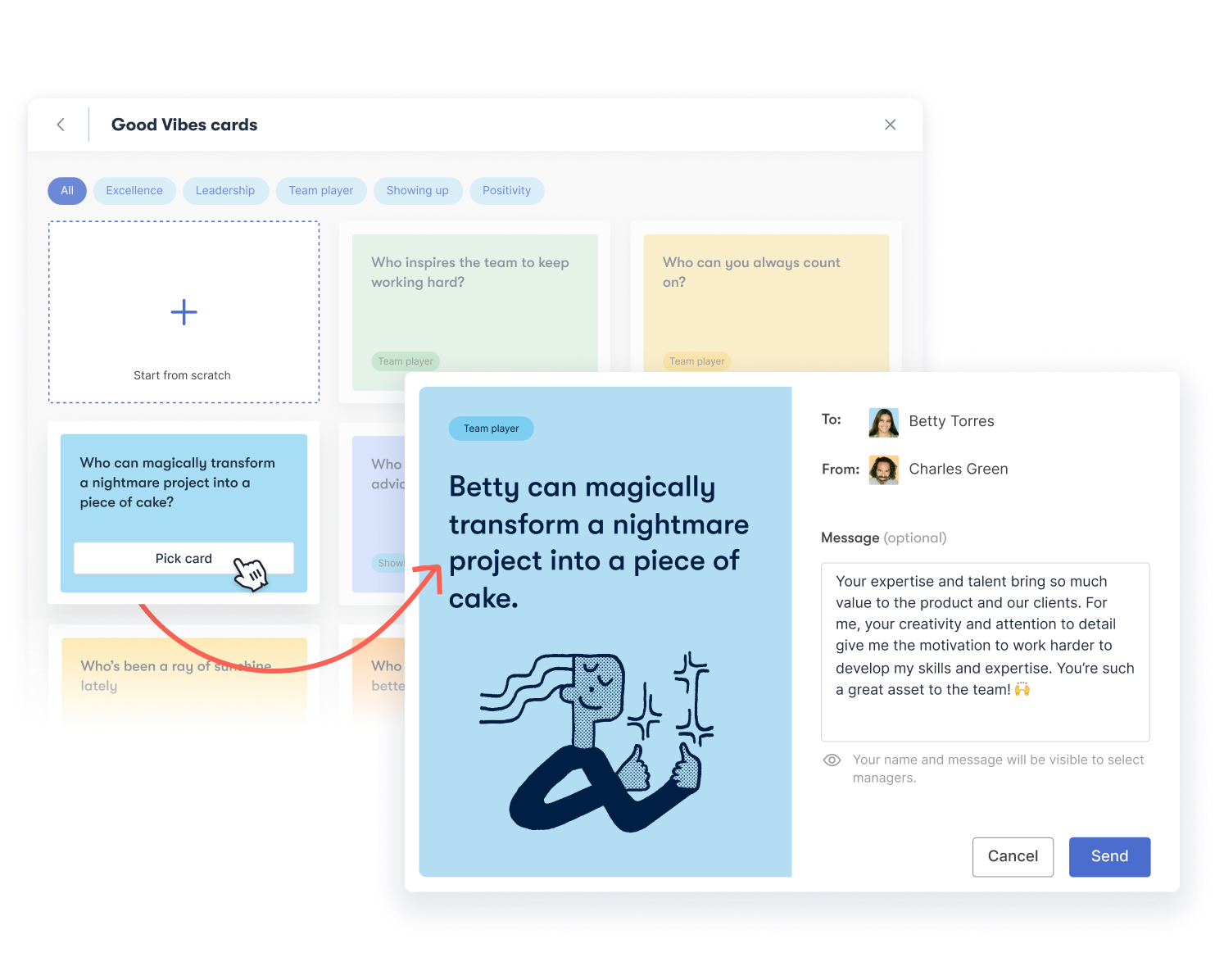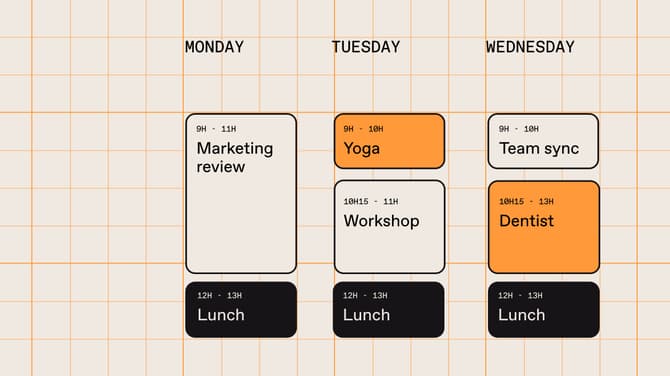Performance reviews are crucial in the workplace as they provide a structured approach to evaluating employee performance. They help foster employee growth and serve as a means to align individual goals with organizational objectives, enhance engagement, and promote open communication.
But effective performance reviews don't happen by accident — every good manager has a trick or two up their sleeves. And you're in luck because we're sharing nine employee performance review tips and tricks for conducting successful performance reviews that benefit both employees and the organization.
Performance management, which includes performance reviews, is a fundamental component of effective HR practices. It's helpful to have a good understanding of its role, so we suggest having a quick read of our comprehensive guide to great performance management to have a well-rounded view!
Assess your organization’s employee experience in minutes

In this article, you will find:
Understanding employee performance reviews
Performance reviews are systematic evaluations of an employee's performance, conducted regularly, to gauge progress and provide feedback. In other words, they are routine, formal one-on-one moments between managers and employees to check in on how things are going, what's going well, and what could be improved, as well as put in place the next course of action to meet performance objectives.
These reviews offer many advantages for both employees and organizations — from driving productivity to improving results. Previously, the annual performance review method was preferred. However, performance management becomes more effective when aligned with the more modern agile performance management approach. Performance reviews that occur more frequently better support employees and nurture a perpetual learning and growing mindset.
Benefits of effective performance reviews
- Improved employee performance: When performance reviews happen regularly, they help identify strengths and weaknesses in real time, enabling employees to improve their skills and performance more effectively. Here you'll find compelling data-backed insights on improving employee performance.
- Goal alignment: Performance reviews are a great opportunity to align individual goals with organizational objectives. This ensures that the entire team is moving in the right direction together. It also ensures everyone is working toward the same targets and understands their contribution to the bigger picture.
- Employee engagement: Regular feedback and recognition through performance reviews are proven to increase employee satisfaction, which in turn fuels engagement. This is a great thing, as engaged employees are more likely to be productive and loyal to the company.
- Clear communication: Effective communication is essential in any workplace. Performance reviews, especially when regular, facilitate and help improve communication between employees and managers and foster a transparent work environment.
- Identification of training needs: Consistent employee performance reviews identify skill gaps and areas of improvement, which help managers design targeted training for employee development. As each employee brings something unique to the table, effective training is about helping them grow within their roles and their teams.
- Performance recognition: Recognizing achievements during reviews can help boost employee morale and motivation to perform well. When employees feel appreciated, they're more likely to perform at their full potential. Praise goes a long way and there are many ways to give effective recognition to drive engagement.
- Feedback loop: Continuous feedback is crucial for personal and professional development. Regular reviews establish a feedback loop that allows ongoing improvement and growth for employees and managers.
- Employee retention: Effective performance reviews demonstrate a commitment to employee growth. This leads to enhanced engagement and retention rates, as employees are less likely to seek opportunities elsewhere when employees see a future within the organization.
- Performance accountability: Reviews hold employees accountable for their performance, promoting responsibility and ownership. It's not just that employees take their roles more seriously when they know their work is being evaluated — it also helps boost pride in what they can own and step up to.
- Talent identification: Identifying high-performing employees helps in talent retention and succession planning. Reviews are useful to help build succession plans that ensure the organization has a pool of talented employees ready to step into leadership roles if and when needed.
Tips for efficient performance reviews
From setting clear objectives and fostering open communication to utilizing technology and mastering the art of constructive feedback, let's explore actionable insights that will empower you to conduct more effective and efficient performance reviews.
Preparing for the performance review
Clear objectives, relevant data, and employee self-assessments are the foundation of a successful employee performance review framework. Let's take a closer look at these three vital steps:
Set clear objectives
Imagine performance reviews as a journey. Clear objectives are your destinations. They provide purpose and direction, making sure everyone knows what to expect.
If the goal is to improve customer service, this should be a central point of discussion during the performance review and broken down into different ways customer service quality can be evaluated. Without this clarity, it's more challenging to determine whether the employee met expectations or not.
Gather relevant data
Collect evidence like a detective solving a case. To crack it, you need data from various sources — lots of it. Reports, project outcomes, customer feedback, peer reviews, and more. It gives you a comprehensive view of performance.
If you're evaluating a salesperson, you'd want to consider relevant performance data like sales figures, customer reviews, and feedback from colleagues about teamwork. This multidimensional view helps ensure a comprehensive employee performance review.
Review employee self-assessments
Here, employees provide their perspectives on their performance, goals, and development areas. Why is this valuable? It encourages self-awareness and opens the door for a more constructive discussion during the actual review. When employees take an active role in assessing themselves, they're more likely to be engaged in the improvement process.
If an employee acknowledges that they need more training in a particular software, it becomes an actionable point for discussion during the performance review — and something to ensure the next steps are set up about.
Creating a positive performance review environment
Performance reviews can be nerve-wracking for both employees and managers, but creating the right environment can make a world of difference.
Encourage open communication
Imagine the review room as a safe space for open dialogue. To create that, encourage employees to share their thoughts, ideas, and even concerns without judgment. Remember, a performance conversation is not one-sided.
Ask questions like, "What challenges have you faced and how can we overcome them?" This two-way communication fosters trust and understanding.
Show empathy and respect
Put yourself in your employees' shoes. Understand that feedback, even when constructive, can be tough to digest. Approach reviews with empathy, acknowledging their efforts and achievements.
For instance, "I appreciate your dedication to the project — let's talk about how we can make it even better." Showing respect in your tone and body language goes a long way in creating a positive and inspiring atmosphere.
Conducting the performance review
Now, let's get to the main event: the employee performance review itself. Ready to master performance evaluations? It's your time to shine as a manager, and here's how:
Focus on specific accomplishments and challenges
Think of this like a performance recap. Highlight specific accomplishments using measurable data. For instance, instead of saying "You did great this quarter," say "Your sales increased by 20% this quarter — that's a fantastic achievement."
On the flip side, address challenges head-on. If there were hiccups, discuss them with clear examples. This paints a vivid picture of what went well and what needs improvement.
Address areas of improvement
Nobody's perfect, right? So, be prepared to talk about areas where your employees can grow. But remember, it's all about how you deliver it. Instead of saying "You're weak in this area," try "Here's how we can work together to strengthen this skill." It's like offering a helping hand rather than pointing fingers.
Provide actionable feedback
Feedback should be like a roadmap, guiding employees to success. Be specific in your advice. If you're discussing time management, don't just say "Manage your time better." Say, "To improve time management, let's start by setting clear priorities and using tools like calendars to schedule tasks." Make it actionable so they know exactly what steps to take.
Use the "sandwich method"
Ah, an oldie but goodie. Start with the "bread" (positive feedback) — celebrate achievements and performance appraisal. Then, slip in the "filling" (constructive feedback) — the stuff that's a bit harder to swallow. This is where you address areas for improvement. Finally, top it off with more "bread" (positive feedback again). Ending on a positive note leaves them motivated and ready to tackle the next challenges.
An example of the sandwich method looks like this: "I appreciate how detail-oriented you are. But sometimes this has you caught up in details which slows you down. It was still great when you delivered X project on time, showing you're able to strike the right balance."
Setting future goals and expectations
The performance review isn't just about evaluating past performance — it's also about the future. And there's a whole science behind it. Here's how to set the stage for future success:
Establish SMART goals
Think of goals as your GPS. They need to be Specific (clear and well-defined), Measurable (quantifiable), Achievable (realistic), Relevant (aligned with company objectives), and Time-bound (with deadlines). SMART goals give a clear direction, making it easier to track progress.
An example of a SMART goal can be:
- Specific: Increase sales revenue.
- Measurable: Achieve a 10% increase in monthly sales compared to the previous quarter.
- Achievable: By implementing a new sales strategy and expanding the client base.
- Relevant: This goal aligns with the company's objective to grow its market share.
- Time-bound: Accomplish this within the next three months.
Align goals with company objectives
Goals should fit seamlessly into the bigger picture of the organization's objectives. When individual goals align with the company's mission, it's like every piece falling into place for a beautiful picture. So make sure every performance review becomes an opportunity to (re)connect those dots.
Let's take an employee working in customer service. One of the company's main objectives is to enhance customer satisfaction and loyalty. The employee's individual goal is to respond to customer inquiries within 24 hours. This goal aligns with the company's objective, as prompt responses contribute to improved customer satisfaction and loyalty!
Dealing with performance challenges
Sometimes, employee performance reviews can get tricky if you have to address certain challenges or issues. Here's how to navigate those waters:
Addressing underperformance
Rather than a negative experience, imagine this as a coaching opportunity. Be supportive and solution-oriented. Say, "I've noticed some challenges in your performance, and I want to help you overcome them." Together, identify the root causes and create an action plan. It's about turning setbacks into comebacks.
Dealing with defensiveness
Picture defensiveness as a bridge you need to cross. When employees get defensive, stay calm. Instead of saying, "You're being defensive," try "I understand this might be difficult to hear. Let's focus on finding solutions." It's like being the bridge that helps them move from defense to progress.
Coaching and development
Now, it's time to coach your employees toward growth and development. While every manager finds their own leadership style, here's how to be their guiding light during and after a performance review:
Create a development plan
Think of this as a map for their career journey. Involve the employee and work together to create a personalized plan that outlines their goals, steps, and timelines. It creates a sense of direction, which helps keep on track with SMART goals but also boosts confidence.
Promote training opportunities
Imagine training opportunities as superpowers for your team. Recommend workshops, courses, or resources that can boost their skills. Say, "I've found a fantastic training program that could enhance your abilities in project management." It's like handing them the keys to self-improvement.
Recognizing and rewarding performance
Recognizing and rewarding your employees is like sprinkling magic dust in the workplace to sustain their mojo — so it's important to make room for it. Here's how to make it happen:
Acknowledge exceptional performance
Imagine exceptional performance as a standing ovation. When someone does exceptionally well, don't let it go unnoticed. Say, "Your dedication to this project was outstanding — it made a real difference." Acknowledgment like this is like applause for their hard work.
Encourage recognition programs and tools
If your company offers recognition programs and tools, make sure employees are aware of them. Leverage peer-to-peer recognition tools that let employees share personal and meaningful messages with their colleagues to let them know they appreciate them.

Documenting the performance review
Documenting the employee performance review keeps things professional, responsible, and accountable. Here's how to do it right:
Importance of accurate documentation
Think of documentation as a safety net. Accurate records protect both you and the employee. It's like keeping receipts for a valuable purchase. We make "documentation" sound admin heavy but it doesn't have to be.
Notes, for example, are great. They ensure you can reference what was discussed and track progress over time. Just like any meeting, take detailed notes during every performance review and share those notes with the employee too.
Confidentiality and privacy
Privacy is crucial, so it's important to ensure that all performance-related information is kept confidential. Even if it's positive stuff — this builds trust, showing employees that their information is in safe hands.
Maybe the employee expressed interest in a particular position they are not comfortable sharing with their peers. As a manager, it's your due diligence to be a trustworthy vault for their professional development.
Following up after the performance review
Although traditionally, companies applied the annual performance review method, an effective employee performance review isn't a one-time event — it's part of an ongoing journey and should happen frequently. Here's how to keep the momentum going with every performance review:
Schedule follow-up meetings
Imagine follow-up meetings as checkpoints in a race. Schedule periodic check-ins to assess progress on goals set during the review. It's like making sure everyone is still on track to reach the finish line. Just like with projects, development happens in steps and stages. Use calendar reminders or automatic memos to help you keep track.
Encourage continuous feedback
Think of continuous feedback as a well-tuned engine. Encourage ongoing communication to foster a culture of improvement. Let employees know that feedback isn't just for reviews — it's a constant process, and feedback will feed into their next performance review meeting.
Remember, regular, constructive feedback isn't just a box to tick — it's the fuel that drives employee growth and keeps your organization firing on all cylinders.
Officevibe: Making performance reviews that work for you
Incorporating all these elements into your performance reviews can transform the experience from a daunting performance evaluation into a valuable opportunity for better feedback, sustained growth, and development.
If you want to take your performance review process to the next level, consider tools like Officevibe. It's not just your average software — it's a trusty sidekick that can seamlessly integrate your existing performance review process. With data visibility and some of the best performance review tips at your fingertips, we're here to help you enhance your team's performance, day in and day out.
Check out what Officevibe can do for your performance reviews. It's time to review, renew, and rock on!
Equip HR and managers with tools to engage, recognize, and drive performance.




